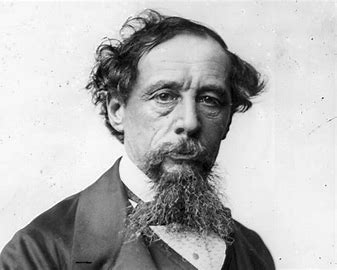Few cities are as closely associated with one writer as London is with Charles Dickens (1812-1870). Though not born in London, Dickens spent much of his life here, and the recurrent motifs in his novels have become the clichés of Victorian London – the fog, the slums and alleys, the prisons and workhouses, and of course the stinking river. Drawing on his own personal experience, he was able to describe the working of the law and the conditions of the poor with an unrivalled accuraracy. He also lived through a time of great social change, during wich London more than doubled in size, yet in his writing London remains a surprisingly compact place: only rarely do his characters venture east of the Tower, or west of St. James’s, with the centre of the city hovering somewhere around the Inns of Court, described in detail in Bleak House.
Born in Portsmouth to a clerk in the naval pay office, Dickens spent a happy early childhood in London and Chatham, on the Kent coast. This was cut short at the age of 12 when his father was imprisoned in Marshalsea debtors’ prison, and Charles was forced to work an in a ratinfested factory in the old Hungerford Market. The experience, though brief, scarred him for life – he was hurt further by his mother’s attempt to force him to keep the job rather than return to school, even after his father’s release. After two years as a solicitor’s clerk at Gray’s Inn, Dickens became a parliamentary reporter, during which time he wrote Sketsches by Boz (Boz was Dickens’ journalistic pen name). The publication of this propelled him to local fame and comparative fortune in 1836, and in the same year he married Catherine Hogarth and moved to the bourgeois neighbourhood of Doughty Street.
There followed nine children – ”the largest family ever known with the smallest disposition to do anything for themselves”, as Dickens later described them – and sixteen novels, each published in monthly instalments, wich were awaited with bated breath by the Victorian public. Then in 1857, at the peak of his career, Dickens fell in love with an 18-year-old actress, Ellen Ternan. His subsequent sepsration from his wife, and his insistence that she leave the family house (while her sister Georgina stayed), scandalized society and forced the author to retrear to his country house in Rochester.
In the last decade of his life, Dickens found an outlet for his theatrical aspirations, and a way of supporting the three households for which he was now responsible, by touring Britain and America giving dramatic readings of his works. He died at his desk at the age of 58, while working on The Mystery of Edwin Drood. According to his wishes, there was no public announcement of his burial, though he was interred in Westminster Abbey (at Queen Victoria’s insistence) rather than in Rochester (as he had requested). The twelve people present at the early-morning service were asked not to wear a black bow, long hatband or any other accessories of the ”revolting absurdity” of mourning.

Ei kommentteja:
Lähetä kommentti